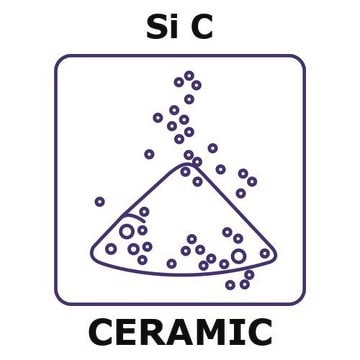594911
Silicon carbide
nanopowder, <100 nm particle size
Synonym(s):
Carbon silicide, Carborundum, Methanidylidynesilanylium, Silicon monocarbide
About This Item
Recommended Products
form
nanopowder
surface area
70-90 m2/g
particle size
<100 nm
mp
2700 °C (lit.)
density
3.22 g/mL at 25 °C (lit.)
bulk density
0.069 g/cm3
SMILES string
[C-]#[Si+]
InChI
1S/CSi/c1-2
InChI key
HBMJWWWQQXIZIP-UHFFFAOYSA-N
Looking for similar products? Visit Product Comparison Guide
Related Categories
General description
Application
- Overview of silicon carbide power devices: This document provides a comprehensive review of the characteristics and applications of silicon carbide (SiC) in power devices, discussing its advantages over traditional silicon devices in handling high voltages and efficiencies (Choi, 2016).
Physical form
Storage Class Code
11 - Combustible Solids
WGK
nwg
Flash Point(F)
Not applicable
Flash Point(C)
Not applicable
Personal Protective Equipment
Certificates of Analysis (COA)
Search for Certificates of Analysis (COA) by entering the products Lot/Batch Number. Lot and Batch Numbers can be found on a product’s label following the words ‘Lot’ or ‘Batch’.
Already Own This Product?
Find documentation for the products that you have recently purchased in the Document Library.
Customers Also Viewed
Articles
Composite materials with micron scale reinforcements offer tailored properties for various applications.
Silica's versatility spans various industries, including biomedical applications.
Three approaches generate white light, including LED-based down-conversion for broader applications.
Our team of scientists has experience in all areas of research including Life Science, Material Science, Chemical Synthesis, Chromatography, Analytical and many others.
Contact Technical Service



